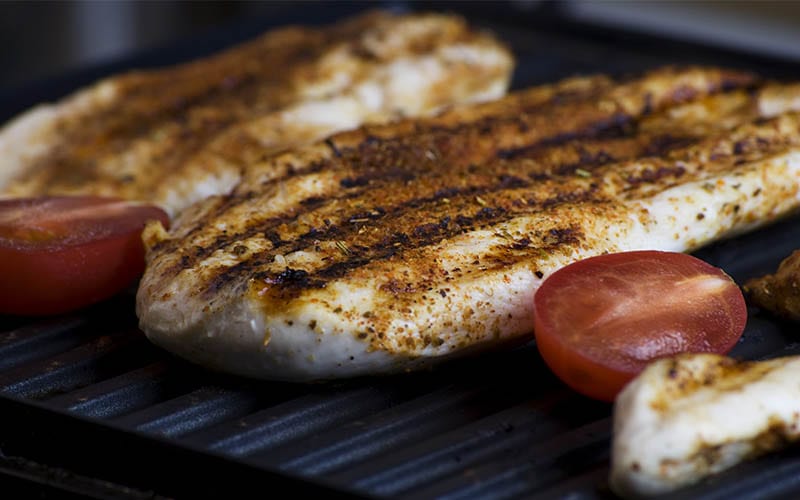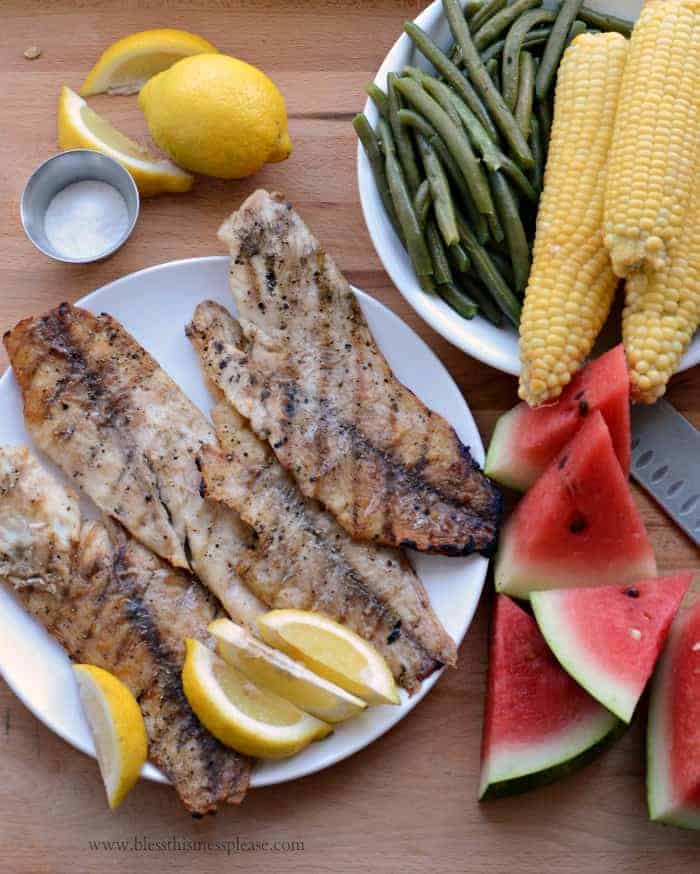Have you ever wondered how to grill fish fillets so that they are perfectly flaky? This recipe is the easiest and best way to grill any firm white fish.
You can serve this tasty flaky fish with almost anything you have on hand, like a fresh vegetable salad, tasty rice, or baked beans.
I like these kinds of recipes because they make it easy to get fresh fruits and vegetables from the farmer’s market or my garden and use them as sides for this simple but tasty grilled fish main dish. It’s simple, it’s classic, and it’s always a hit in this house.
Grilling white fish can seem intimidating, but it doesn’t have to be with the right techniques. White fish like cod, halibut, tilapia, and more can make for a fast, healthy, and delicious grilled meal The key is knowing how to prep, season, and grill the fish so that it turns out moist and flaky every time.
In this detailed guide, I’ll walk through my foolproof process for grilling white fish fillets to perfection. I’ve been grilling fish for years, and these are the best tips I’ve learned along the way for getting professional results right in your own backyard.
Getting Started – Choosing and Prepping the Fish
The first step is selecting the right type of white fish You’ll want to look for fillets that are about 1⁄4 to 1⁄2 inch thick This thickness allows the fish to cook evenly without drying out. Good options include
- Cod
- Tilapia
- Halibut
- Mahi mahi
- Orange roughy
- Flounder
I recommend purchasing fillets with the skin on. The skin helps hold the fish together, adds flavor, and prevents it from sticking to the grill. Simply peel off the skin after cooking if desired.
Once you’ve selected your fillets pat them completely dry with paper towels. This helps ensure they cook up nice and crisp. It also allows any seasoning or oil to evenly coat the fish.
The Importance of Proper Seasoning
Seasoning is essential for bringing out the flavor of mild white fish. At a minimum, you’ll want to generously season both sides with salt and pepper. I also like to add garlic powder, paprika, lemon pepper, or Italian seasoning blend.
In addition to dry seasoning, drizzling the fillets with olive oil is key. The oil helps the fish develop a delicious crisp exterior on the grill. I recommend using about 1 tablespoon of olive oil per 1 pound of fish. Using a brush makes it easy to evenly coat both sides of the fillets.
Once seasoned, allow the fillets to sit at room temperature for 15-20 minutes before grilling. This helps them absorb the flavors.
Grilling Methods for Perfect Results
To prevent sticking, it’s crucial to oil the grill grates right before adding the fish. Use a grilling brush to coat the grates with a thin layer of oil. I like using a high-heat oil like avocado, grapeseed, or refined coconut oil.
There are two easy methods I recommend for grilling white fish fillets:
Direct Grilling
This technique involves placing the fillets directly on the hot grill grates. It allows you to get nice grill marks and char.
To prevent the fish falling through the grates, I recommend using a fish grilling basket. Simply place the fillets in the basket, close it, and set it directly on the grill grates.
Grill the fish over direct medium-high heat for 4-5 minutes per side, with the lid closed as much as possible. Check for doneness at the 4 minute mark by carefully lifting the basket and peeking at the fish. It should release easily when ready.
Indirect Grilling
This method involves placing the fillets on a lightly oiled sheet of foil and grilling over indirect heat. The fish essentially steams in its own juices, keeping it very moist and tender.
To use this technique, light coals on one side of the grill only. Place the foil with the fish on the empty side and grill over medium heat with the lid closed for 8-12 minutes until the fish flakes easily with a fork.
I recommend tenting the foil loosely with a second sheet to help retain even more moisture.
Doneness and Serving
The fish is fully cooked when it turns opaque and flakes easily with a fork. Take care not to overcook, as fish dries out quickly.
Once cooked, immediately remove the fillets from the grill and sprinkle with a squeeze of fresh lemon juice. I like serving grilled white fish with rice pilaf, grilled veggies, or a fresh salad on the side. Slices of lemon make a nice garnish.
The fish tastes best right off the grill, but leftovers will keep refrigerated for 2-3 days. Simply reheat gently in the microwave or oven.
Grilled Fish Marinade and Sauce Ideas
While grilled white fish is delicious with just olive oil, salt, and pepper, marinades and sauces can take it to the next level. Try the following easy recipes:
Lemon Garlic Marinade
- 1/3 cup olive oil
- 3 cloves garlic, minced
- Zest and juice from 1 lemon
- 1 tbsp dried oregano
- Salt and pepper to taste
Whisk together ingredients and marinate fish for 10-20 minutes before grilling.
Mango Pineapple Salsa
- 1 ripe mango, diced
- 1/2 pineapple, diced
- 1 jalapeno, seeded and minced
- 2 tbsp cilantro, chopped
- Juice of 1 lime
- Pinch of salt
Stir together salsa ingredients. Spoon over grilled fish fillets to serve.
Cilantro Lime Drizzle
- 1/3 cup olive oil
- Zest and juice from 1 lime
- 1/4 cup cilantro, chopped
- 1 tsp honey
- Salt and pepper to taste
Mix drizzle ingredients. Drizzle over hot grilled fish just before serving.
Helpful Tips and Tricks
- Allow thicker fillets to marinate for up to 30 minutes to help flavors penetrate fully.
- If marinating, pat fish dry again before grilling to prevent steaming.
- If fish sticks initially, let it sear longer before trying to flip.
- Cook fillets of uniform thickness at the same time for even cooking.
- Brush cooked fish with melted butter or olive oil before serving for added richness.
Get Grilling!
With these techniques, you can master grilling moist, flaky white fish fillets in your own backyard. Guaranteed to please a crowd, it makes for a quick and healthy dinner any night of the week. Experiment with different seasoning blends and marinades to put your own spin on this classic grilled fish recipe.

How to Buy the Freshest Fish
Just because you don’t live near water doesn’t mean you can’t find delicious, fresh fish. Here are some tips when deciding what fish to buy.
Fish that is sold as “fresh” can range from 1 day to two weeks out of the water. Ships that fish often stay out at sea for a few weeks and freeze their catch before coming back to port.
For the best fish, look for FAS, which stands for “Frozen at Sea,” or “Individually Quick-Frozen” (IQF).
This means that as soon as the fish was caught, it was filleted and flash frozen on board the ship. When it is thawed it tastes the closest to fresh caught fish.
When shopping for fish, Individually Quick-Frozen (IQF) is another good choice because the fish are flash-frozen within hours of being caught. Each fillet is individually packaged and inspected for quality. If you buy IQF-labeled fish, check the packaging for freezer burn or ice crystals that could change the taste of the fish.
If the fish is packaged, look for clean and dry packaging. I like to buy fish that was caught in the wild, and if it’s frozen, I like it when each piece is individually sealed. It will let me take out only the ones I need while leaving the rest frozen. I have great luck buying high-quality fish at Costco.
When buying fresh fish, there are a few things to look for. First, trust your nose. If the fish smells strongly of fish, it could mean that it is old and beginning to go bad.
Another aspect to look for is the fish’s skin. The skin should be shiny with some slime on the surface. That is a mark of quality and freshness. Fresh fish should also have clear and bright eyes. Steer clear of fish with cloudy or red eyes.
Why You’ll Love This Recipe
- Simple, easy, and fast recipe.
- As a side dish, it goes with almost anything you have on hand.
- It works well for cod, pollock, tilapia, and other white fish.
- Filets of fish: Choose a mild, firm white fish like tilapia, cod, pollock, or Louisiana Drum. Grilling fish works best with thin, flat fillets.
- Instead of olive oil, you can use a light oil like canola, vegetable, or avocado. If you want to keep the oil from breaking down and giving off bad flavors at high temperatures, use one with a high smoke point (400°F or more).
- Lemon: A small amount of lemon makes the taste better.
- Parsley: Optional as a garnish.
- Salt and pepper: I like to use Kosher salt and black pepper that has just been ground.
See the recipe card below for full information on ingredients and quantities.

